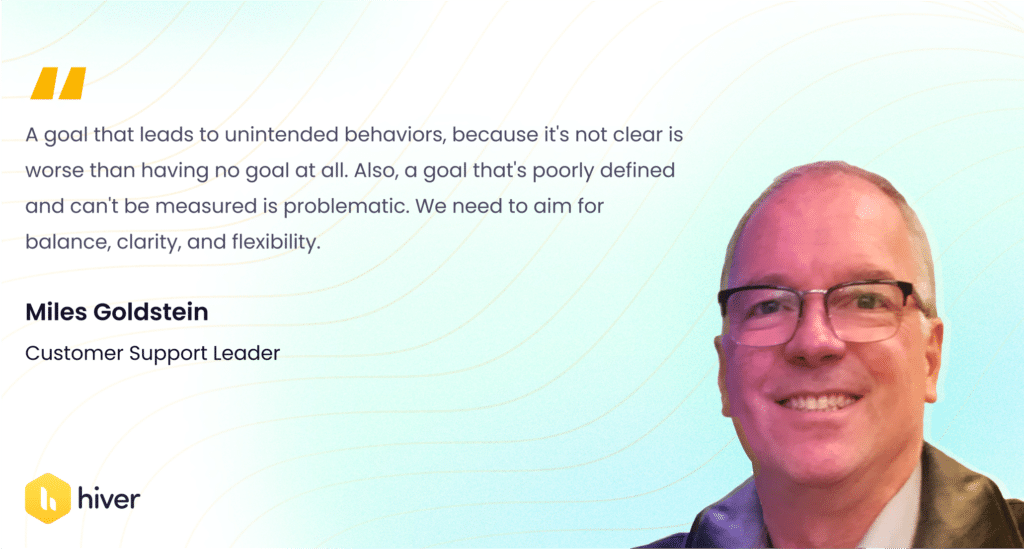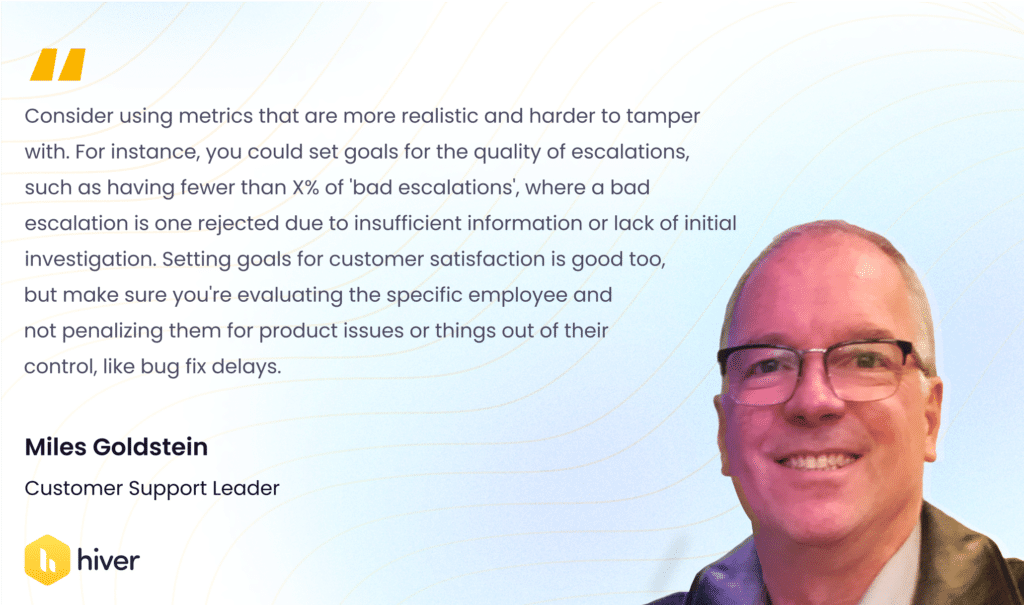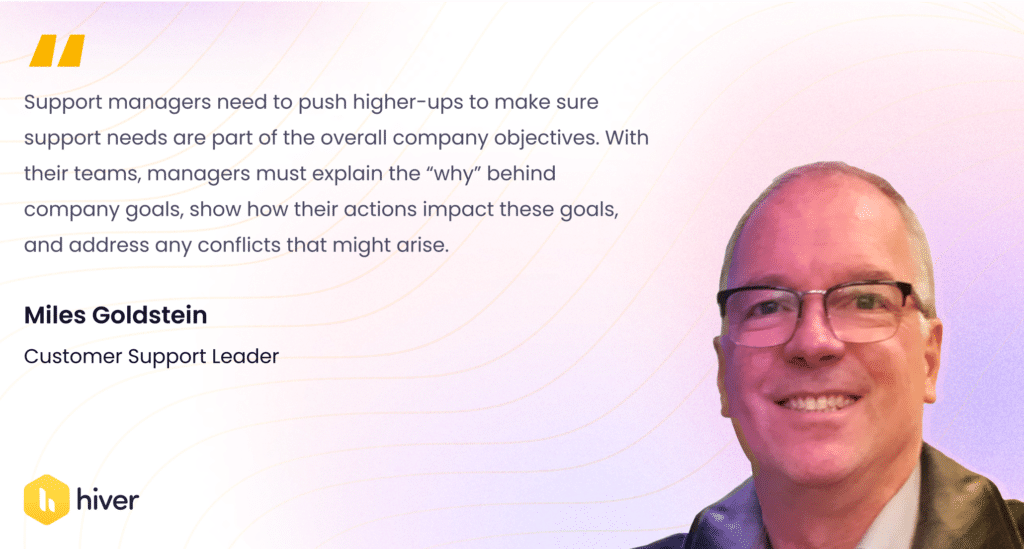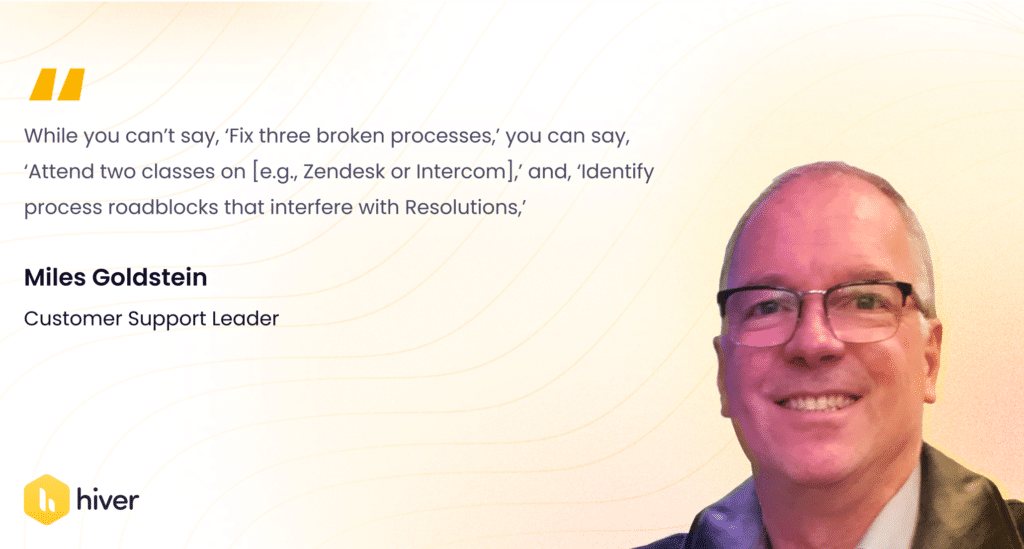Top Ways to Set SMART Goals for Customer Support Teams

Table of contents
Proper goal setting in customer support teams is very crucial.
It’s more than just about hitting targets; it’s about shaping how teams interact with customers and handle daily tasks. Good goals can boost team performance and ultimately improve customer satisfaction, while poorly set goals can lead to confusion in the team.
However, finding that sweet spot where goals are neither too daunting nor too easy is a skill in itself. To know more about this, I talked to an expert who knows all about this balance.
Miles Goldstein, Customer Support Leader, is known for building high-performing support teams. He’s big on setting SMART goals—those that are specific, measurable, achievable, relevant, and time-bound.
Miles’ methods aim to build a culture that values continuous improvement and top-notch customer service.
In this blog, we’ll look at how the right SMART goals can help support teams do better and stay motivated, without getting burned out.
Q1. How can SMART goals be effectively implemented within a customer support team?
In theory, goals are supposed to guide us towards desired behaviors and outcomes. However, it’s important to set these goals carefully to avoid unexpected problems. They should be designed to improve the customer experience without leading to negative behaviors in pursuit of those goals.
For instance, if you only set a goal to close customer queries quickly without considering customer satisfaction, it might lead to cases being closed too soon, which can upset customers.
You need to pick metrics that lead to the outcomes you want, are hard to manipulate, and clearly explain what you’re aiming for. Sometimes, you might even need to set balancing goals to keep things in check.
Flexibility is also key; if job conditions or the environment changes, employees should have the option to switch to tasks that still align with the original goal’s intent.
Q2. What are some examples of SPECIFIC goals that customer support teams can set?
I’m a big supporter of continuous improvement, whether it’s about quality, processes, or personal skills. My team often has goals related to their personal and professional development.
They also have goals aimed at enhancing our processes, tools, and service offerings. These goals can be a bit vague and don’t always fit neatly into SMART goals, but they’re important because they help improve customer satisfaction.

Q3. How can support teams ensure their goals are MEASURABLE, and what metrics should they track?
You can measure “Support 101” statistics like backlog, closure times, cases per full-time employee (FTE),contacts per call, and time spent on cases, but these are just rough indicators of what’s really happening. They can even encourage bad behavior.
For example, if you set a goal based on cases-per-FTE, team members might only handle easy cases or stop working once they hit their target. For time spent per case, there’s a risk they might report misleading data to meet their goals. If you lose sight of the “North Star” – which is improving customer experience – then you end up with a meaningless checklist with no actual benefit.

You can also set goals related to following processes and policies. If employees find a problem, fixing it could count towards their ‘process improvement’ goals. These don’t need explicit numbers but can still be somewhat objectively tracked.
Goals could also include reducing the number of complaints or the need for rework from customer queries assigned to them, although getting accurate data here might be tough. This approach is particularly useful for an employee on a performance improvement plan, where you can clearly see their progress from a defined starting point.
Q4. Can you share strategies for setting ACHIEVABLE goals that challenge support teams without causing burnout?
I often say, “Customers never call in just to say, ‘Everything is fine; have a great day.'” To prevent staff burnout, managers need to do several things.
The main point of this interview is about setting reasonable goals. Managers should check in with their staff regularly, not just during reviews. It’s important to see how they’re doing, understand any personal issues that might affect their work, identify any obstacles they’re facing in meeting their goals, and ensure they have a good work-life balance. While these might seem like clichés, it’s crucial to keep an eye on their well-being.
To keep goals engaging and challenging, they should be personally meaningful to the employee. That’s why I favor goals that include personal and professional development. For instance, if someone finds relaxation in basket weaving, I might encourage them to take a class. This approach helps them feel more invested and motivated in their other goals, instead of feeling like every goal is just another task to “shovel more mud.”
Q5. How can customer support managers align team goals with broader company objectives to ensure they are RELEVANT?
Company goals need to be consistent across the board. Think about those “unintended consequences” I mentioned. For example, if Sales is pushed to increase the number of new accounts, they might end up selling to customers who don’t really fit our product. If Support is then tasked with keeping customers, there’s a conflict, because some of those customers might actually need to leave. Everyone in the company should focus on customer churn rates to make smarter decisions.
Also, if the company aims to reach a certain number of customers or revenue target but isn’t investing in Support to help achieve those goals, there’s a conflict.

Q6. What are some best practices for defining TIME-BOUND goals that keep support teams focused and motivated?
I’m a big fan of dashboards. They can be real-time, like monitoring an incoming case queue, or they can be updated weekly. When one of the companies I worked in was setting up Knowledge Management, we had a weekly scorecard tracking things like new articles written, how many cases were linked to articles, and how many articles were linked to cases. We also ran a contest among teams to see who could get the highest weekly score. This bit of competition really helped keep everyone engaged and excited.
Q7. Can you provide examples of how SMART goals have led to tangible improvements in customer support operations?
I set a goal for one of my teams to reduce “bad escalations” to Engineering, and it led to several positive outcomes:
- We created better runbooks for Support, which helped solve problems faster.
- It improved how we used our Engineering resources, again speeding up resolution times.
- Support’s reputation got better throughout the company, which led to more recognition and rewards.
- Our staff developed their skills further, opening up more growth opportunities within the company.
Q8. What training or resources are essential for support teams to understand and effectively use the SMART framework?
I’ve taken several courses on SMART goals and read many articles, but I still find it challenging to set them in Support. It’s easy to pull out a bunch of numeric targets or basic “Support 101” statistics since they fit the SMART criteria. But do they really lead to the behaviors and outcomes we want? I think managers need to be careful.

Q9. What are some common pitfalls to avoid when setting SMART goals for customersupport teams?
I keep thinking about those unintended consequences. You shouldn’t set goals like, “Solve x number of cases,” “Close x% of cases within [timeframe],” or “Write x number of knowledge articles,” without some balance to prevent people from gaming the system.
Without guidelines that reinforce our main objective—to improve the customer experience—people might end up doing the wrong things just to meet their targets.
Conclusion
Miles has given us some excellent tips on setting SMART goals. These ideas are bound to make a difference when you’re setting goals for your support teams. Let’s break down some key points from this interview to keep in mind:
- Aim for balance: It’s important not to focus solely on numbers. Set goals that encourage your team to handle cases thoroughly without rushing and avoiding any shortcuts.
- Keep the end goal in sight: Every goal should contribute directly or indirectly to improving the customer experience. This means setting objectives that enhance the customer experience, not just fill quotas.
- Adapt as needed: As and when circumstances change, so should your goals. If you find that a particular goal isn’t serving your team or customers well, be ready to adjust it. This keeps your goals relevant and keeps your team motivated.
Create goals that not only push your team to achieve more but also support them in providing the best possible service to your customers. Miles’ insights are a great starting point for examining how your goals align with your team’s abilities and customers’ needs.

































